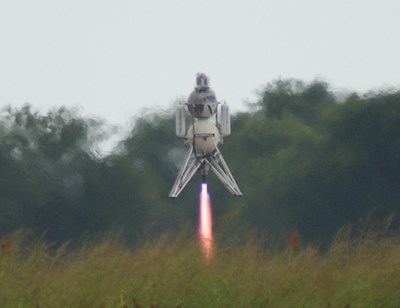
Armadillo Aerospace's Scorpius vehicle on a flight as part of the Lunar Lander Challenge in September 2009.
On Monday NASA announced that it has made $475,000 in awards to Armadillo Aerospace and Masten Space Systems for experimental flights of suborbital reusable vehicles. These are the first contracts for test flights under the agency’s Commercial Reusable Suborbital Research (CRuSR) program, which is designed to support flight opportunities on commercial suborbital vehicles for a variety of research purposes. The flights will take place at Spaceport America in New Mexico (for Armadillo) and Mojave Air and Space Port in California (for Masten) this fall and winter, reaching altitudes of between 5 and 40 kilometers.
The announcement coincided with a “Flight Opportunities” panel at the AIAA Space 2010 conference Monday afternoon in Anaheim, California. As it turned out, it wasn’t much of a panel session: most of the scheduled panelists were unavailable for one reason or another, but officials from the CRuSR program and the NASA Office of the Chief Technologist (CRuSR’s parent organization) were present and offered some additional details beyond what was in the NASA release. For example, the $475,000 awarded was split roughly evenly between the two companies, with one getting approximately $250,000 and the other approximately $225,000. (I was later told that Masten got the slightly larger award.)
The NASA press release mentioned that the vehicle will be carrying antennas to support the Automatic Dependent Surveillance-Broadcast (ADS-B) navigation system for the FAA, but that will not be the only payload they will carry. Dougal Maclise said at the panel session that the vehicles will also carry a “flight monitor” from NASA Ames to measure the flight environment of the vehicles, including acceleration and vibration. A third payload is a “particle agglomeration” experiment from the Space Sciences Lab at the University of California Berkeley tat has previously flown on the ISS. The key requirements for all the experiments, he said, is that they be “self-sufficient, autonomous, and expendable”.
The flights will begin as soon as October, with Armadillo flying out of Spaceport America; the Masten flights will begin late this year. Those two companies were pretty much the only ones who could meet CRuSR’s requirements to perform test flights, even at relatively low altitudes, within six months of contract award (a requirement in the solicitation). Virgin Galactic has not yet started glide tests of SpaceShipTwo, let alone powered flights, while XCOR Aerospace will not be ready to begin vehicle tests in the next six months. (Blue Origin’s status is more secretive, as usual for them, but there’s no evidence they are in an active flight test program.)

Leave a Reply